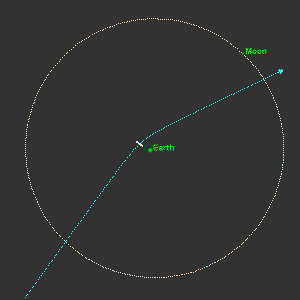Discovery Of Asteroid 2004 MN4 And Possible Collision With Earth
Asteroid 2004 MN4 was discovered on the 19th of June 2004 by Roy Tucker, David Tholen and Fabrizio Bernardi of the University of Hawaii Asteroid Survey from Kitt Peak Arizona. It is a minor planet of about 400m diameter. It was viewed over a period of two nights.
The asteroid was rediscovered on the 18th of December 2004 by Gordon Garradd of the Siding Spring Observatory. After a few days it was recognized that it would make several close approaches to Earth in the 21st century. The highest theoretical chance of an impact on Friday the 13th of April 2029 was 1/37. However after archival research by Jeff Larsen and Anne Descour in Arizona, any chance of impact with Earth was ruled out, underlining the importance of precovery observations. The closest distance the asteroid will come to Earth on this day is 36,700km at 9.45pm. Calculations of the asteroid's orbit suggest it will be close enough to view with the naked eye, passing by with a speed of 8km/s. If it were to collide, the force of impact would be 1000 mega tonnes of TNT which is equal to 4.2x10^18 J, which is equivalent to twenty 50-megaton hydrogen bombs simultaneously exploding.
| Date | Nominal Distance (AU) | Minimum Possible Distance (AU) | Close Approach Probability |
| 2029 04 13 .90654 | 0.0002391 | 0.0001813 | 1 |
These distances were calculated by the Near Earth Object Dynamic Site using data available up to 2005 February, to check for updates go to Near Earth Object Dynamic Site
The above table shows the calculated data about the close approach by asteroid 2004 MN4 on the 13th April 2029.

| Observatory | Date | R.A. | Decl. | Delta | r | V | Sky Motion ("/min) |
| Kitt Peak | 2029 04 13 22:00:00 (UTC) | 07 55 18.8 | +34 26 49 | 0.00020 | 1.003 | 3.9 | 3175.92 |
| Armagh | 2029 04 13 22:00:00 (UTC) | 06 49 47.9 | +30 08 30 | 0.00020 | 1.003 | 4.5 | 2985.02 |
Around the time of closest approach the parallax is huge, as shown in table above.
| Observatory | Date | R.A. | Decl. | Delta | r | V | Sky Motion ("/min) |
| Kitt Peak | 2004 06 19 12:00:00 (UTC) | 09 45 34.0 | +13 14 21 | 1.144 | 1.015 | 21.5 | 2.03 |
| Armagh | 2004 06 19 12:00:00 (UTC) | 09 45 34.2 | +13 14 21 | 1.144 | 1.015 | 21.5 | 2.03 |
Usually the parallax is a lot smaller, for example this table shows the sky positions around the time of discovery.
Other links
PHA Close Approaches To The Earth
Armagh Observatory Impact Hazard Page
NASA's Near Earth Object Program Office
Last Revised: 2005 February 25th
